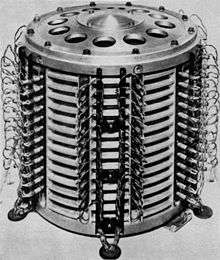Drum memory


| Computer memory types |
|---|
| Volatile |
| RAM |
| In development |
| Historical |
|
| Non-volatile |
| ROM |
| NVRAM |
| Early stage NVRAM |
| Mechanical |
| In development |
| Historical |
|
Drum memory was a magnetic data storage device invented by Gustav Tauschek in 1932 in Austria.[1] It was widely used in the 1950s and into the 1960s as computer memory.
For many early computers, drum memory formed the main working memory of the computer. It was so common that these computers were often referred to as drum machines.[2] Some drum memories were also used as secondary storage.[3]
Drums were displaced as primary computer memory by magnetic core memory which was faster (no moving parts), less expensive and more dense. Similarly, drums were replaced by hard disk drives for secondary storage, which were also less expensive and more dense. The manufacture of drums ceased in the 1970s.
Design
A drum memory contained a large metal cylinder, coated on the outside surface with a ferromagnetic recording material. It could be considered the precursor to the hard disk drive (HDD), but in the form of a drum rather than a flat disk. In most designs, one or more rows of fixed read-write heads ran along the long axis of the drum, one for each track. The drum's controller simply selected the proper head and waited for the data to appear under it as the drum turned (rotational latency). Not all drum units were designed with each track having its own head. Some, such as the English Electric DEUCE drum and the Univac FASTRAND had multiple heads moving a short distance on the drum in contrast to modern HDDs, which have one head per platter surface.
The performance of a drum with one head per track is determined almost entirely by the rotational latency, whereas in an HDD its performance includes a rotational latency delay plus the time to position the head over the desired track (seek time). In the era when drums were used as main working memory, programmers often did optimum programming -- the programmer[NB 1] positioned code on the drum in such a way as to reduce the amount of time needed for the next instruction to rotate into place under the head. They did this by timing how long it would take after loading an instruction for the computer to be ready to read the next one, then placing that instruction on the drum so that it would arrive under a head just in time. This method of timing-compensation, called the "skip factor" or "interleaving" (interleaving in disk storage), was used for many years in storage memory controllers.
Use and legacy
Tauschek's original drum memory had a capacity of about 500,000 bits (62.5 kilobytes).[1]
The drum could be removed and connected to another output system, but this was not done often due the size and complications that could occur.
One of the earliest functioning computers to employ drum memory was the Atanasoff–Berry computer. However, it employed capacitance rather than magnetism to store information. The outer surface of the drum was lined with electrical contacts leading to capacitors contained within.
The first mass-produced computer, the IBM 650, had about 8.5 kilobytes of drum memory (later doubled to about 17 kilobytes in the Model 4).
As late as 1980, PDP-11/45 machines using magnetic core main memory and drums for swapping were still in use at many of the original UNIX sites.
In modern-day BSD Unix and its descendants, /dev/drum is the name of the default virtual memory (swap) device, deriving from the use of drum secondary-storage devices as backup storage for pages in virtual memory.[5]
Drum memory is referenced in The Story of Mel, in which the skilled programmer Mel optimizes programs written for a drum memory computer (the RPC 4000) by taking advantage of the time to process an instruction and the time for the drum to rotate so that the next instruction or data can be read.
See also
- CAB500
- Karlqvist gap
- Manchester Mark 1
- Random-access memory
- Wisconsin Integrally Synchronized Computer
- Carousel memory (magnetic rolls)
Notes
References
- 1 2 Universität Klagenfurt (ed.). "Magnetic drum". Virtual Exhibitions in Informatics. Retrieved 2011-08-21.
- ↑ Datamation, September 1967, p.25, "For Bendix and Ramo-Wooldridge, the G-20 and RW-400 were parallel core machines rather than serial drum machines of the type already in their product lines."
- ↑ e.g., IBM 2301 Drum Storage
- ↑ SOAP II - Symbolic Optimal Assembly Program for the IBM 650 Data Processing System, (PDF), IBM, 24-4000-0
- ↑ "FreeBSD drum(4) manpage". Retrieved 2013-01-27.
External links
| Wikimedia Commons has media related to Drum memory. |
- The Story of Mel: the classic story about one programmer's drum machine hand-coding antics: Mel Kaye.
- Librascope LGP-30: The drum memory computer referenced in the above story, also referenced on Librascope LGP-30.
- Librascope RPC-4000: Another drum memory computer referenced in the above story
- Oral history interview with Dean Babcock